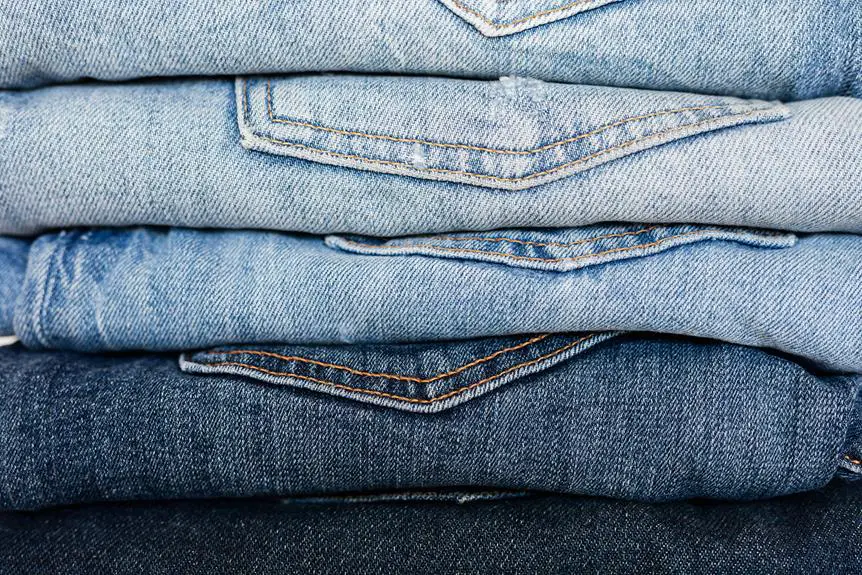When you're tumbling your laundry, maintaining fabric quality isn't just a matter of tossing everything in and hitting start. You need to consider the type of fabric you're working with, adjust your dryer settings accordingly, and pay attention to drying times. It's also wise to separate your fabrics by type and color to prevent any mishaps. If you think that's all there is to it, think again—there are additional strategies that can significantly enhance the longevity of your clothes. Ready to explore some effective techniques?
Table of Contents
Key Takeaways
- Always separate fabrics by type and color to prevent dye transfer and damage during tumbling.
- Use appropriate dryer settings: low heat for delicate fabrics and medium or high heat for durable materials.
- Monitor drying time closely; adjust based on fabric type to avoid over-drying and potential wear.
- Utilize dryer balls to enhance airflow, reduce drying time, and minimize static cling without increasing heat.
Understand Fabric Types
To maintain fabric quality, you first need to understand the different types of fabrics and their unique properties. Each fabric reacts differently to heat, moisture, and tumbling, so knowing what you're working with is crucial.
For instance, cotton is durable and can withstand high temperatures, making it a popular choice for everyday wear. On the other hand, delicate fabrics like silk or lace require special care; exposing them to high heat can lead to irreversible damage.
Next, consider synthetic fabrics like polyester or nylon. These materials are generally resilient and resistant to wrinkles, but they can also melt if the dryer heat is too high. You'll want to check the care labels; they'll provide specific instructions tailored to each fabric type.
Additionally, blends, such as cotton-polyester, combine properties from both materials, so understanding the dominant fabric can help guide your drying choices.
By familiarizing yourself with these fabric types, you can make informed decisions that preserve their quality, ensuring your clothes last longer and maintain their appearance.
Use Appropriate Dryer Settings
Using the right dryer settings is crucial for keeping your fabrics in top shape.
You need to select suitable heat levels, adjust drying times, and utilize fabric-specific cycles to prevent damage.
Making these adjustments can significantly extend the life of your clothes.
Select Suitable Heat Levels
Selecting the right heat level when drying your fabrics can prevent damage and keep them looking their best. High heat can cause shrinkage, fading, and even fabric breakdown, so it's crucial to choose the appropriate setting for each fabric type. Always check the care label for guidance; it's your best resource for understanding how to treat each item.
Here are some tips to help you select the right heat level:
- Low Heat: Ideal for delicate fabrics like silk and lace, preventing any potential damage.
- Medium Heat: Works well for cottons and blends, ensuring a balanced drying without excessive heat exposure.
- High Heat: Best reserved for durable fabrics like towels and bed linens, but use sparingly to avoid wear.
Adjust Drying Time
Adjusting drying time based on fabric type ensures your clothes come out fresh and undamaged. Each fabric reacts differently to heat and moisture, so it's essential to tailor your drying settings accordingly. For example, delicate fabrics like silk or lace require shorter drying times to prevent damage, while heavier materials such as towels or jeans may need longer.
To achieve the best results, start by checking the care labels on your garments. These labels often provide specific drying instructions that can guide you in setting the appropriate time. If you're unsure, opt for a shorter drying cycle and check on your clothes periodically. You can always add more time if needed, but removing items too late can lead to shrinking or fabric wear.
Also, consider the moisture level of your laundry before starting the dryer. If your clothes feel damp but aren't soaking wet, reducing the drying time can help maintain fabric integrity.
Utilize Fabric-Specific Cycles
Choosing fabric-specific cycles on your dryer can significantly enhance the longevity and appearance of your clothes. When you select the right settings, you minimize wear and tear, ensuring your fabrics stay vibrant and intact. Here's why it's essential to utilize these cycles:
Temperature Control: Different fabrics require different heat levels. Using a lower heat setting for delicate items prevents damage.
Drying Time: Fabric-specific cycles often adjust the drying time automatically, ensuring clothes aren't over-dried.
Moisture Detection: Many modern dryers come with sensors that detect moisture levels, allowing for optimal drying without the risk of shrinking or scorching.
Gentle Tumbling: Some cycles mimic air drying by using gentler tumbling motions that protect your garments.
Separate Colors and Fabrics
When you wash your fabrics, separating colors and types is essential to keep them looking their best.
You'll want to test for colorfastness to prevent any unwanted dye transfer.
Additionally, considering the fabric type will help you choose the right washing and drying methods for each item.
Colorfastness Testing Methods
Colorfastness testing methods are essential for ensuring that your fabrics maintain their vibrant hues even after repeated washing or exposure to sunlight. By conducting these tests, you can identify how well different colors and materials hold up under various conditions.
Here are some effective methods you can use:
- Wash Test: Simulate washing conditions by soaking your fabric in detergent and water, then examine any color changes.
- Lightfastness Test: Expose your fabric to UV light for a set duration to see how it resists fading.
- Bleach Test: Apply a small amount of bleach to a hidden part of the fabric to check for color alteration.
Fabric Type Considerations
Understanding how different fabric types interact with various colors can significantly impact the longevity and appearance of your textiles.
When you're mixing fabrics in a tumble dryer, it's crucial to separate them by type. For instance, cottons tend to absorb dyes more readily than synthetics, meaning they can bleed into lighter fabrics.
You should always wash similar colors together, especially when dealing with darker or vibrant hues. Mixing bright colors with whites or pastels can lead to unwanted discoloration. Additionally, fabrics like silk or wool are more delicate and require gentler handling compared to sturdier materials like denim or polyester.
If you do mix fabrics, consider using a color catcher sheet to capture any loose dyes. This can help mitigate the risk of color transfer.
Also, pay attention to the care labels; some fabrics may require air drying instead of tumbling to maintain their shape and color.
Invest in Dryer Balls
Investing in dryer balls can significantly enhance your laundry experience by reducing drying time and minimizing static cling.
These handy tools work by separating your clothes as they tumble, allowing hot air to circulate more efficiently. This not only shortens drying time but also helps prevent fabric from clumping together, which can lead to wrinkles.
Here are some benefits of using dryer balls:
- Reduced Wrinkles: The bouncing action helps keep fabrics separated, reducing the chance of wrinkles forming.
- Natural Fabric Softening: Many dryer balls are made from wool or other natural materials, providing a chemical-free way to soften fabrics.
- Reusable: Unlike dryer sheets, which you toss after a single use, dryer balls can last for years, making them a cost-effective choice.
Monitor Drying Time
While dryer balls help reduce drying time, it's important to monitor how long your clothes actually spend in the dryer to maintain their fabric quality. Overdrying can lead to shrinking, fading, and fabric wear, so keeping an eye on the clock is crucial. You should aim for the right balance—drying your clothes just enough to remove moisture without sacrificing their integrity.
Here's a quick reference table to help you gauge optimal drying times for different fabrics:
| Fabric Type | Recommended Drying Time | Notes |
|---|---|---|
| Cotton | 30-40 minutes | Can handle higher heat |
| Synthetics | 20-30 minutes | Use lower heat settings |
| Delicates | 15-20 minutes | Use air dry or low heat |
Care for Delicate Garments
Caring for delicate garments requires extra attention to ensure they stay in great condition and maintain their quality. When tumbling dry, you need to be cautious to avoid damaging fabrics like silk, lace, or chiffon.
Follow these tips for the best results:
- Use a mesh bag: Place delicate items inside a mesh laundry bag to provide extra protection during the tumbling process.
- Select a low heat setting: High temperatures can weaken fibers, so opt for the lowest heat setting available on your dryer.
- Limit drying time: Check your garments frequently and remove them while they're still slightly damp. This helps prevent unnecessary wear and tear.
Frequently Asked Questions
Can I Tumble Dry All Types of Fabrics Safely?
You can't safely tumble dry all fabrics. Delicate materials like silk or wool often shrink or get damaged. Always check care labels, and opt for air drying when in doubt to preserve your garments' longevity.
How Do I Prevent Static Cling in Tumble-Dried Clothes?
To prevent static cling in your tumble-dried clothes, add dryer balls or use a fabric softener. You can also try drying clothes in smaller loads to enhance airflow and reduce static buildup effectively.
What Should I Do if Clothes Shrink in the Dryer?
If your clothes shrink in the dryer, try air-drying them next time. You can also wash in cold water, use gentle cycles, and avoid high heat to help maintain their original size and shape.
Can I Use Fabric Softener With Tumble Drying?
Yes, you can use fabric softener when tumble drying. It helps reduce static and makes fabrics feel softer. Just follow the instructions on the fabric softener and your dryer for best results.
How Often Should I Clean My Dryer Lint Filter?
You should clean your dryer lint filter after every use. This practice helps improve airflow, reduces fire hazards, and ensures your dryer operates efficiently. It only takes a moment, so make it a routine habit.
- Tetron Fabric for Marine Applications: Durability and Use Cases - June 18, 2025
- Tetron Fabric for Outdoor Furniture: Weather Resistance and Care - June 18, 2025
- Tetron Fabric for Wall Coverings: Style and Application Tips - June 18, 2025







